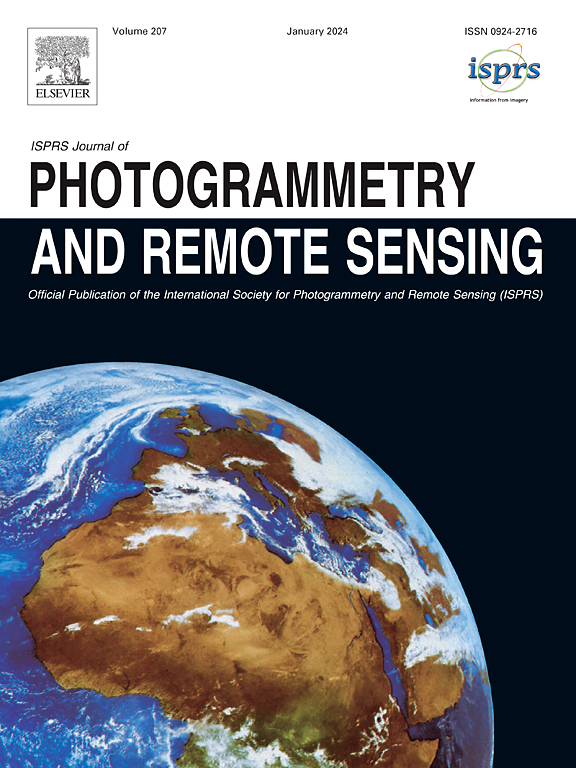PRISMA imaging for land covers and surface materials composition in urban and rural areas adopting multiple endmember spectral mixture analysis (MESMA)
IF 10.6
1区 地球科学
Q1 GEOGRAPHY, PHYSICAL
ISPRS Journal of Photogrammetry and Remote Sensing
Pub Date : 2025-05-04
DOI:10.1016/j.isprsjprs.2025.04.038
引用次数: 0
Abstract
Covers and surface materials composition of urban, peri-urban and rural landscapes is significant information for environmental, climate and human-ecosystems interaction monitoring and modeling, as well as for addressing specific urban planning and improving environmental management. In this study the multiple endmember spectral mixture analysis (MESMA) was exploited to overcome the low spatial resolution and spectral mixture of the hyperspectral (HS) satellite PRISMA (PRecursore IperSpettrale della Missione Applicativa). A multi-level detail large-scale mapping of complex urban and rural fractional composition of land covers and surface materials (LCSM) was carried out. High-resolution airborne data enabled the collection of pure endmembers for each impervious and pervious surface materials, also acting as a reference for assessing resulted sub-pixel fractional covers at the pixel scale. Absolute Errors (AE) have shown that MESMA is very promising for quantifying complex landscape composition at the sub-pixel level from PRISMA HS data (overall AE <=0.282; per-class AE < 0.336, with average values even < 0.1 for some classes). Bias Errors (BE) instead attested that under- and overestimation errors for each class were contained in ±0.25 median values for all three levels of detail (i.e., number of classes) tested. These results demonstrate that the proposed framework integrating MESMA and PRISMA HS is a valuable tool to provide detailed land composition in complex landscapes to support urban planning and enhance environmental sustainability.
基于多端元光谱混合分析(MESMA)的PRISMA城乡土地覆被和地表物质组成成像
城市、近郊和乡村景观的覆盖物和地表物质组成是环境、气候和人类生态系统相互作用监测和建模的重要信息,也是解决具体城市规划和改善环境管理的重要信息。为了克服高光谱卫星PRISMA (precursoiperspettrale della Missione Applicativa)的低空间分辨率和光谱混合问题,利用多端元光谱混合分析(MESMA)技术进行了研究。对复杂的城乡土地覆盖和地表物质分异组成(LCSM)进行了多层次详细大比例尺制图。高分辨率的航空数据可以收集每个不透水和透水表面材料的纯端元,也可以作为评估像素尺度下亚像素分数覆盖的参考。绝对误差(AE)表明,MESMA非常有希望从PRISMA HS数据中量化亚像素级的复杂景观组成(总体AE <;=0.282;按类AE <;0.336,平均值为偶数<;某些类为0.1)。相反,偏倚误差(BE)证明了每个类别的低估和高估误差包含在所有三个细节水平(即类别数量)测试的±0.25中位数中。这些结果表明,将MESMA和PRISMA HS结合起来的框架是一个有价值的工具,可以在复杂景观中提供详细的土地组成,以支持城市规划和提高环境可持续性。
本文章由计算机程序翻译,如有差异,请以英文原文为准。
求助全文
约1分钟内获得全文
求助全文
来源期刊

ISPRS Journal of Photogrammetry and Remote Sensing
工程技术-成像科学与照相技术
CiteScore
21.00
自引率
6.30%
发文量
273
审稿时长
40 days
期刊介绍:
The ISPRS Journal of Photogrammetry and Remote Sensing (P&RS) serves as the official journal of the International Society for Photogrammetry and Remote Sensing (ISPRS). It acts as a platform for scientists and professionals worldwide who are involved in various disciplines that utilize photogrammetry, remote sensing, spatial information systems, computer vision, and related fields. The journal aims to facilitate communication and dissemination of advancements in these disciplines, while also acting as a comprehensive source of reference and archive.
P&RS endeavors to publish high-quality, peer-reviewed research papers that are preferably original and have not been published before. These papers can cover scientific/research, technological development, or application/practical aspects. Additionally, the journal welcomes papers that are based on presentations from ISPRS meetings, as long as they are considered significant contributions to the aforementioned fields.
In particular, P&RS encourages the submission of papers that are of broad scientific interest, showcase innovative applications (especially in emerging fields), have an interdisciplinary focus, discuss topics that have received limited attention in P&RS or related journals, or explore new directions in scientific or professional realms. It is preferred that theoretical papers include practical applications, while papers focusing on systems and applications should include a theoretical background.
 求助内容:
求助内容: 应助结果提醒方式:
应助结果提醒方式:


